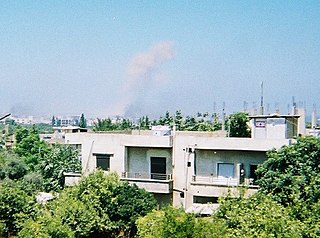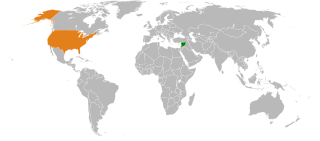Related Research Articles

Ansar al-Islam in Kurdistan, simply called Ansar al-Islam, is a Kurdish Islamist militant and separatist group. It was established in northern Iraq around the Kurdistan Region by Kurdish Islamists who were former Taliban and former Al-Qaeda volunteers, which were coming back from Afghanistan in 2001 after the Fall of Kabul. Its motive is to establish an Islamic state around the Kurdistan region and to protect Kurdish people from other armed insurgent groups. It imposed strict Sharia in villages it controlled around Byara near the Iranian border. Its ideology follows a traditionalist interpretation of the Quran and Salafism.
Jund al-Sham is or was the name of multiple Sunni Islamic jihadist militant groups.

Terrorism in Saudi Arabia has mainly been attributed to Islamic extremists. Their targets included foreign civilians—Westerners affiliated with its oil-based economy—as well as Saudi Arabian civilians and security forces. Anti-Western attacks have occurred in Saudi Arabia dating back to 1995. Saudi Arabia itself has been accused of funding terrorism in other countries, including Syria.
Terrorism in Syria has a long history dating from the state-terrorism deployed by the Ba'athist government since its seizure of power through a violent coup in 1963. The Ba'athist government have since deployed various types of state terrorism; such as ethnic cleansing, forced deportations, massacres, summary executions, mass rapes and other forms of violence to maintain its totalitarian rule in Syria. The most extensive use of state terrorism in the 20th century was during 1970s and 1980s, when Islamic uprisings across Syria where crushed through bloody campaigns of intense repression, culminating in the Hama massacre which killed around 40,000 civilians.

Fatah al-Islam is a radical Sunni Islamist group that formed in November 2006 in a Palestinian refugee camp, located in Lebanon. It has been described as a militant jihadist movement that draws inspiration from al-Qaeda. It became well known in 2007 after engaging in combat against the Lebanese Army in the Nahr al-Bared UNRWA Palestinian refugee camp. Following its defeat at Nahr el-Bared, the group relocated to the Ain al-Hilweh refugee camp near Sidon in 2008. As of 2014, after the death or capture of many members, most of the surviving members of Fatah al-Islam are thought to have joined other groups in Lebanon and Syria including the Free Syrian Army, Al-Nusra Front, Ahrar al-Sham, and the Islamic State of Iraq and the Levant.

The 2007 Lebanon conflict began when fighting broke out between Fatah al-Islam, an Islamist militant organization, and the Lebanese Armed Forces (LAF) on May 20, 2007 in Nahr al-Bared, a UNRWA Palestinian refugee camp near Tripoli.

Diplomatic relations between Syria and the United States are currently non-existent; they were suspended in 2012 after the onset of the Syrian Civil War. Priority issues between the two states include the Arab–Israeli conflict, the Golan Heights annexation, Iraq War, alleged state-sponsorship of terrorism, occupation of Lebanon, etc.

The Abdullah Azzam Brigades, or al-Qaeda in Lebanon, is a Sunni Islamist militant group, and al-Qaeda's branch in Lebanon. The group, which began operating in 2009, was founded by Saudi Saleh Al-Qaraawi and has networks in various countries, mainly in Egypt, Iraq, Syria, Jordan, the Gaza Strip and Lebanon.
On 23 December 2011, two seemingly coordinated bombings occurred in the Syrian capital of Damascus. The alleged suicide car bombs exploded outside Syrian military intelligence agency buildings, killing 44 people and injuring 166. According to Syrian state media, most of the dead were civilians. The attacks took place during the Syrian uprising. The Syrian government blamed Islamist militants, while the Syrian opposition accused the government of staging the attacks to justify its crackdown on the uprising.

Al-Nusra Front, also known as Front for the Conquest of the Levant, was a Salafi jihadist organization fighting against Syrian Ba'athist government forces in the Syrian Civil War. Its aim was to overthrow president Bashar al-Assad and establish an Islamic state in Syria.

Harakat Ahrar al-Sham al-Islamiyya, commonly referred to as Ahrar al-Sham, is a coalition of multiple Islamist units that coalesced into a single brigade and later a division in order to fight against the Syrian Government led by Bashar al-Assad during the Syrian Civil War. Ahrar al-Sham was led by Hassan Aboud until his death in 2014. In July 2013, Ahrar al-Sham had 10,000 to 20,000 fighters, which at the time made it the second most powerful unit fighting against al-Assad, after the Free Syrian Army. It was the principal organization operating under the umbrella of the Syrian Islamic Front and was a major component of the Islamic Front. With an estimated 20,000 fighters in 2015, Ahrar al-Sham became the largest rebel group in Syria after the Free Syrian Army became less powerful. Ahrar al-Sham and Jaysh al-Islam are the main rebel groups supported by Turkey. On 18 February 2018, Ahrar al-Sham merged with the Nour al-Din al-Zenki Movement to form the Syrian Liberation Front.
The inter-rebel conflict during the Syrian Civil War has continued throughout the Syrian Civil War as factions of the Syrian opposition and Free Syrian Army have fought each other, with shifting alliances among various Islamist factions such as Jabhat al Nusra, Ahrar al-Sham, Jaysh al-Islam and the Islamic Front.

Jund al-Aqsa, later known as Liwa al-Aqsa after 7 February 2017, was a Salafist jihadist organization that was active during the Syrian Civil War. Formerly known as Sarayat al-Quds, the group was founded by Abu Abdul 'Aziz al-Qatari as a subunit within the al-Nusra Front. The group later became independent, because al-Nusra was growing too rapidly for its resources and had suffered from fighting the Islamic State of Iraq and the Levant. On 20 September 2016 the U.S. Department of State designated Jund al-Aqsa as a terrorist organization. The group rejoined al-Nusra Front, by then renamed Jabhat Fateh al-Sham (JFS), in October 2016. However, on 23 January 2017, JFS declared that Jund Al-Aqsa was no longer part of Jabhat Fateh Al-Sham. In early February 2017, some of Jund al-Aqsa's units joined the newly formed Tahrir al-Sham, while the others refused and formed a new splinter group called Liwa al-Aqsa, and captured many towns in northern Hama and southern Idlib from other rebel groups. Following these attacks, Tahrir al-Sham launched a military operation against Liwa al-Aqsa, accusing them of being an ISIL affiliate. Following intense clashes with Tahrir al-Sham, up to 2,100 Liwa al-Aqsa militants left Idlib Province to join ISIL in Raqqa Province, by 22 February 2017.

Ahmed Hussein al-Shar’a, known by the nom de guerreAbu Mohammad al-Julani, is the commander-in-chief of the Syrian militant group Tahrir al-Sham.
The following is a timeline of the Syrian Civil War from January to April 2016. Information about aggregated casualty counts is found at Casualties of the Syrian Civil War.

Hay'at Tahrir al-Sham, commonly referred to as Tahrir al-Sham, is a Sunni Islamist political and armed organisation involved in the Syrian Civil War. It was formed on 28 January 2017 as a merger between Jaysh al-Ahrar, Jabhat Fateh al-Sham (JFS), Ansar al-Din Front, Jaysh al-Sunna, Liwa al-Haqq, and Nour al-Din al-Zenki Movement. The unification process was held under the initiative of Abu Jaber Shaykh, an Islamist commander who had been the second Emir of Ahrar al-Sham.
The East Ghouta inter-rebel conflict was an armed conflict between the rebel groups Tahrir al-Sham and al-Rahman Legion on one side, and the rebel group Jaysh al-Islam on the other, which took place in the rebel-held territories east of Damascus. Open conflict between the groups also took place exactly one year earlier, before a ceasefire was implemented.

On 19 February 2018, heavy clashes erupted between the newly established Syrian Liberation Front, which consists of Ahrar al-Sham and the Nour al-Din al-Zenki Movement, backed by the Suqour al-Sham Brigades, and Hayat Tahrir al-Sham (HTS) in the western Aleppo Governorate. The conflict soon spread to the Idlib Governorate and the SLF captured several towns from HTS. A ceasefire between the two groups was reached on 24 April 2018. Fighting again resumed on 1 January 2019, ending with a total HTS military victory on 9 January.
Insurgency in Idlib is an ongoing insurgency in the regions Idlib Governorate between multiple factions. The conflict is primarily between the supporters of Syrian Salvation Government and forces loyal to Syrian Arab Republic. Other factions participating in insurgency range from the Syrian opposition forces in the Syrian National Army supported by Turkey; to supporters of Al-Qaeda branch Hurras al-Din and members of the Islamic State group. The insurgency has been marked by assassinations and bombings, as well as armed confrontations with small arms and raids.
References
- ↑ Moshe Gat. The Jewish exodus from Iraq, 1948-1951, Routledge, 1997. pg. 188. ISBN 0-7146-4689-X.
- ↑ Yazīd Ṣāyigh. Armed struggle and the search for state: the Palestinian national movement, 1949-1993, Oxford University Press US, 1997. pg. 72. ISBN 0-19-829265-1.
- ↑ "Syrian police clash with bombers". 28 April 2004.
- ↑ "Syria blames Islamists for bomb". 15 May 2004.
- ↑ "Five die as Syria thwarts attack". 2 June 2006.
- ↑ "The Islamic Revival in Syria (September-October 2006)". www.mideastmonitor.org. Archived from the original on 2007-02-22.
- ↑ "Foiled Attack in Damascus: Terrorists Try to Storm US Embassy in Syria". Der Spiegel. 12 September 2006.
- ↑ "Chinese diplomat hurt in Syria blast".
- ↑ Surviving Embassy Attacker Dies
- ↑ Syria says assailants against U.S. embassy not related to foreign extremists
- ↑ Damascus Bus Bomb: 'Up To 12' Killed In Syria Explosion, Albert Aji, 3 December 2009.
- ↑ "Syrian Al-Qaeda affiliate claims twin bombing in Damascus". BBC News. 12 March 2017.
- ↑ "Tahrir al-Sham: Al-Qaeda's latest incarnation in Syria". BBC News. 28 February 2017